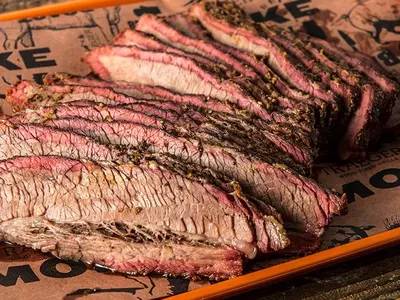
This is the best way to smoke a brisket, worthy of any true Texan. This full packer is injected with Butcher’s Prime, sprayed down with apple juice, rubbed with a prime rib and coffee rub mix, topped with black pepper, and smoked over cherry wood to tender perfection.
1/3 (12-15 lb) whole packer brisket
1/4 Cup Butcher BBQ Prime Brisket Injection
2/3 Cup water
2/3 Tablespoon Canola oil
1/2 Cup apple juice
1/8 Cup Traeger Prime Rib Rub
1/8 Cup Traeger Coffee Rub
2/3 Tablespoon Freshly ground black pepper
Trim the fat cap off the top of the brisket and remove all silverskin. Trim off any brown areas around the sides of the brisket. Make a long cut with the grain on the flat (thin) side of the brisket and a short cut again on the flat to show direction of cuts after cooking. Trim the bottom fat cap to about 1/4 inch thick.
1/3 (12-15 lb) whole packer brisket
In a large liquid measuring cup, combine the Butcher BBQ Prime Brisket Injection and water. Use a meat injector to inject the mixture into the brisket with the grain in a checkerboard pattern. Rub the entire brisket with canola oil, then spritz with apple juice and let sit for 30 minutes. Reserve the remaining injection mixture.
1/4 Cup Butcher BBQ Prime Brisket Injection
2/3 Cup water
2/3 Tablespoon Canola oil
1/2 Cup apple juice
When ready to cook, set the Traeger temperature to 180℉ and preheat with the lid closed for 15 minutes. For optimal flavor, use Super Smoke if available.
Grill: 180 ˚F
In a small bowl, combine the Traeger Prime Rib and Coffee Rubs. Season the brisket with the rub mixture, then sprinkle the black pepper over the top.
Grill: 180 ˚F
1/8 Cup Traeger Prime Rib Rub
1/8 Cup Traeger Coffee Rub
2/3 Tablespoon Freshly ground black pepper
Insert the probe into the thickest part of the brisket. Place the brisket directly on the grill grates, fat-side down. Close the lid and cook until the internal temperature reaches 150-160°F, 8-12 hours, spritzing with apple juice every 30-45 minutes after the first 3 hours.
Probe: 160 ˚F
Remove the brisket from the grill and increase the grill temperature to 225°F.
Grill: 225 ˚F
The texas bbq brisket is taken from the cow’s front, underside, right above the forelegs. A complete brisket can weigh up to 13 pounds, thus it is frequently sliced into two smaller portions: the flat cut and the point cut. A number of crucial elements are also present in a single serving of flat cut bbq brisket.
1. Protein– The protein found in bbq brisket is regarded as complete protein, meaning that it contains all of the essential amino acids needed by the body to manufacture protein compounds.
2. Fat– Brisket includes nearly 6 grams of total fat, 2 grams of saturated fat and 80 milligrams of cholesterol in every 84-gram, 3-ounce serving. These totals fall below the USDA’s specifications that states that beef cuts should have no more than 10 grams of total fat.
3. Vitamins- Beef brisket is an important source of the B vitamins, containing vitamin B12, vitamin B6, riboflavin and niacin.Out of these B vitamins, used by the body for efficient energy metabolism, 3 ounces of beef contains 37 percent of the RDA for vitamin B12,
4. Minerals– You can find high concentrations of minerals like zinc, iron, phosphorus and selenium in texas bbq brisket. It is a more readily absorb able source of the mineral than zinc contained in plant-based foods.